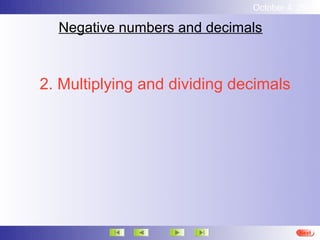
Negative numbers multiplying and dividing
- 1. October 4, 2012 Negative numbers and decimals 2. Multiplying and dividing decimals Next
- 2. Explanation October 4, 2012 e n s When you multiply a decimal by 10, or a multiple of 10, the digits s h de dn uh t r all move to the left, according to how many “0”s there are. thousandths s de dnuh s eno s h ne t t The decimal point stays put. ×× 10 ÷100 0 6 6 1 r When dividing by a multiple of × 10 ÷ 2 0 0 9 10, each digit moves to the right, according to how many “0”s there are. If the digits all move beyond the decimal point, you must write a zero in the “ones” column. As it is easier, we actually move just the decimal point, but remember that this represents moving all the digits the other way. More Next
- 3. Practise October 4, 2012 3.92 × 100 392 22.4 ÷ 100 0.224 0.83 × 10 8.3 14.7 ÷ 10 1.47 0.02 × 1000 20 8,390 ÷ 1000 8.39 More Next
- 4. Explanation October 4, 2012 Multiplying two decimal numbers. First, ignore the decimal points. 3.24 × 2.3 Multiply. 3.24 × 2.3 = 7452 Count and total the number of digits after both decimal points, 2 1 3 in the original calculation. The decimal point should have this number of digits after it, in 7452 . you answer. More Next
- 5. Practise October 4, 2012 3.92 × 2.2 8.624 22.4 × 1.37 30.688 0.83 × 2.96 2.4568 14.7 × 3.745 55.0515 0.02 × 16.8 0.336 11.66 × 4.853 56.58598 More Next
- 6. Explanation October 4, 2012 Dividing two decimal numbers. First, write the division as a fraction. 3.24 ÷ 2.4 Multiply both the denominator and the 3.24 numerator by 10, or 100 or any other 2.4 power of 10, so that the denominator is a whole number. If you can, cancel , then divide as normal. 1.35 8 12 24 32.4 0 More Next
- 7. Practise October 4, 2012 3.12 ÷ 2.4 1.3 7.02 ÷ 1.3 5.4 2.728 ÷ 0.88 3.1 23.836 ÷ 5.7 4.18 0.03 ÷ 0.025 8.5 114.75 ÷ 4.25 27 More Next End